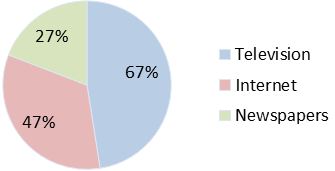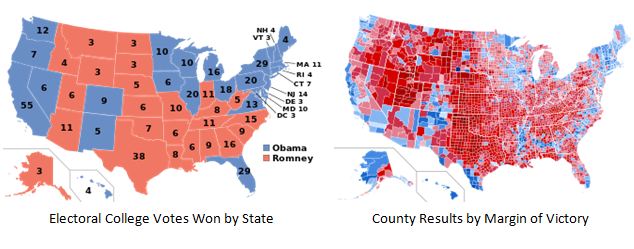2012 US Presidential Election
The 2012 Presidential election was held on Tuesday, November 6 (as were elections for all 435 seats in the House of Representatives, for 33 Senate seats, gubernatorial races in 11 states, and many other state and local offices).
The results of the Presidential vote were as follows:
 Turnout: 58.9%[1]
Turnout: 58.9%[1]
ANALYSIS
Context
President Barack Obama sought re-election during a time of continued economic uncertainty. He was the first president since Franklin Roosevelt to seek an additional term of office with unemployment at more than 7.2% (it was 7.9%). Mr. Obama also went into the election having disappointed many supporters who expected his presidency to have accomplished more; nonetheless, principal achievements included:
• legislation designed to provide near-universal insurance coverage for health care costs;
• negotiating a stimulus package of tax cuts and federal spending in response to the fiscal crisis of 2008;
• ending the war in Iraq, to redeploy troops to fight insurgencies in Afghanistan; and
• ordering the mission that found and assassinated Osama bin Laden.
Twelve candidates sought to head the Republican ballot, including:
• Mitt Romney (former Massachusetts governor);
• Rick Santorum (former Pennsylvania Senator);
• Ron Paul (US Representative from Texas); and
• Newt Gingrich (former House Speaker) from Georgia.
The only woman to seek the party’s nomination, Representative Michele Bachmann of Minnesota, withdrew on January 4, 2012. Earlier, in December 2011, former New Mexico governor Gary Johnson withdrew to seek the nomination of the US Libertarian Party (he would eventually receive 1.3 million votes).
During the campaign for the nomination, Mr. Romney successfully portrayed himself as the candidate most capable of challenging the President. By the beginning of May 2012 it was clear that he had enough committed delegates to be named the presumptive candidate by the Republican National Committee.
The first presidential debate was held on October 3, 2012. Throughout the previous month, Obama led Romney by a margin of at least two percentage points in every national poll but two. Immediately following the debate (in which polls and pundits alike awarded the advantage to Romney), the lead in the polls, if there was one, went to Romney. However, Obama was widely viewed as having performed better in the second and third debates, the latter held on October 22, 2012. From that point on, in the 44 national poll results reported after the final debate, eight results showed a lead for Romney, and eight showed a tie: the remaining 28 showed a lead for Obama.
Having campaigned for the Republican nomination as a conservative, Romney recast himself as a moderate once he faced Obama after the August convention. One of his notable misjudgements was to identify (in a closed-door fund raiser that was taped) the poorest 47% of the electorate as automatic Obama voters because of their reliance on government programs. His campaign was not assisted by the public musings of two prominent Republican Senate candidates (Todd Akin, Missouri and Richard Mourdock, Indiana) on rape and pregnancy. Many observers believe that Romney did not adequately communicate a clear set of alternative policies.
The Results
Although the two candidates split the number of states almost evenly between them, Obama won states with the larger numbers of electoral college votes. In particular, the Obama team enjoyed success in key “battleground” states: winning Ohio, Florida, Virginia, Wisconsin, Iowa, New Hampshire, Nevada and Colorado; only North Carolina went Republican. The Romney-Ryan ticket was the first major party ticket to lose the home states of both candidates, Massachusetts for Romney and Minnesota for Ryan, in the former case by the largest margin since the Civil War.
Among other news organizations, CBS reported that Romney’s team had anticipated a very different outcome than what emerged on election night.[2]
The campaign workers were so secure in this belief that the candidate had failed to prepare a concession speech in the event that the results were otherwise (as they were).
How the Vote Split
According to the Pew Research Foundation, exit polling by the National Election Pool revealed clear differences in voting behaviour related directly to societal cleavages, in particular gender, age, ethnicity, and income. Women, who made up a majority (53%) of voters, also favoured Obama, by a margin of 11%. Men voted for Romney, by a 7% margin.
As in 2008, the majority of voters under age 45 voted for Obama, by a margin of 23% in the 18 to 29 year old bracket.
While Romney won the white vote (by 20%), Obama won the African American vote by 87% (93% to 6%) and the Hispanic vote by 47% (71% to 27%).
Pew also reports that a majority of Americans believed that the economic system favours the rich, that a majority believed Romney’s policies would favour the economically advantaged, and that a plurality believed Obama’s policies would favour the middle class.[3]
BBC Analysis Reinforces
Analysis by the BBC confirmed that those earning less than $50,000 voted for Obama by a margin of more than 20%. The exit polling also indicated that Obama was the strong favourite of those voters motivated by health care and foreign policy concerns, while Romney was the favourite of those voters concerned about the size of the US deficit. The 59% of Americans who identified the economy as their greatest concern split almost evenly between the two tickets (51% for Romney).[4]
Evaluating the Campaign
The US election has never been one to examine policy options in great detail; it is a sad indictment of the state of democracy in the US when Pew Research leads off its article (Low Marks for the 2012 Election) with the following observation:
“The 2012 presidential campaign was a frustrating experience for many voters, who say the campaign was more negative than usual and had less discussion of issues than in most previous campaigns. Both Obama and Romney get mixed grades for the job they did reaching out to voters, as do campaign consultants, the press and pollsters. On most measures, voters’ views of campaign 2012 fall short of the election four years ago.” [5]
Notwithstanding their negative views of the campaign, more voters reported feeling satisfied with the choice of presidential candidates than in any of the previous six elections. In addition, the percentage of those reporting that they had learned enough to make an informed choice increased (as it has since being reported at 59% in the 1988 contest) to 87%.
Among those participants evaluated by voters, the press received the lowest ratings. Interestingly, this was the year in which use of the Internet as a “main source” of Internet coverage reached 47%, above newspapers but below television.
 Republican voters were more likely to lack confidence in the accuracy of the national vote count (79% compared to 58% of Democratic voters), and more likely to believe that the press coverage of the campaign had been unfair.
Republican voters were more likely to lack confidence in the accuracy of the national vote count (79% compared to 58% of Democratic voters), and more likely to believe that the press coverage of the campaign had been unfair.
Polarizing Parties
The clearest picture that emerges from early analyses of the 2012 contest is one of parties less disposed to work together post-election. The Pew survey confirms a more general impression that Republicans are less disposed to work with their opponents, with a majority supporting the idea of moving in a more conservative direction. Among Democrats, the mood is slightly more accommodating, with a slight majority (+12%) supporting cooperation with Republicans; a stronger gap exists (+24%) between those favouring moderation over moving to more liberal positions.[6]
This impasse will be reflected in a divided Congress in which the Democrats hold a Senate majority, but not enough seats to block a filibuster, while Republicans hold a majority in the House of Representatives. It is perhaps telling that of those surveyed by the Pew Foundation after Election Day, 53% of Americans felt that blame for any impasse on a deal to address the so-called fiscal cliff would belong to the Republicans, compared to 29% to the Democrats.[7]
Republicans Challenged by Changing Demographics
One explanation for the failure of the Republicans to capitalize on a general unease with the federal state is the polarization within the party; the rise of Tea Party supporters is said to have driven many moderate Republicans from being placed before the electorate (if not from the Party itself). At the same time, many conservatives argue that the party failed because it was not conservative enough. This ignores the fact that the demographic segments with which the Party had the most traction were the wealthy, white males, and evangelical Christians. The proportion of Americans who are female, black and/or Hispanic has been rising in the last several elections and is projected to continue to do so in the future. Women constituted 53% of the electorate in 2012 and voted for Obama by a margin of 11%. As noted by the BBC, white males no longer constitute a majority of the Democratic Party caucus.[8] Since 2007, unmarried women have become a majority, one that split almost 2 to 1 for Obama in 2012. In other words, the 2012 election outcome reflects the new demographic realities of the US. Some have suggested the Republican Party needs to adopt a message that addresses the concerns of these demographic segments if they are to be competitive in future contests.[9]
Notes
1. See United States Elections Project at http://elections.gmu.edu/Turnout_2012G.html.
2. See Jan Crawford, Adviser: Romney “shellshocked” by loss, at http://www.cbsnews.com/8301-250_162-57547239/adviser-romney-shellshocked-by-loss.
3. See Changing Face of America Helps Ensure Obama Victory at http://www.people-press.org/2012/11/07/changing-face-of-america-helps-assure-obama-victory/.
4. See Exit Polls Anatomise Obama Win at http://www.bbc.co.uk/news/world-us-canada-20240375.
5. See Low Marks for the 2012 Election at http://www.people-press.org/2012/11/15/low-marks-for-the-2012-election/.
6. Ibid.
7. See The “Fiscal Cliff” and Public Opinion at http://www.pewresearch.org/2012/11/21/the-fiscal-cliff-and-public-opinion/.
8. See Kate Daley, US Election: Women are the New Majority, at http://www.bbc.co.uk/news/magazine-20231337.
9. See David Frum, Why Republicans Lost—But Can Win Again, at http://www.ft.com/cms/s/0/7126cda4-2e7f-11e2-9b98-00144feabdc0.html#axzz2L65uJ9qa.


